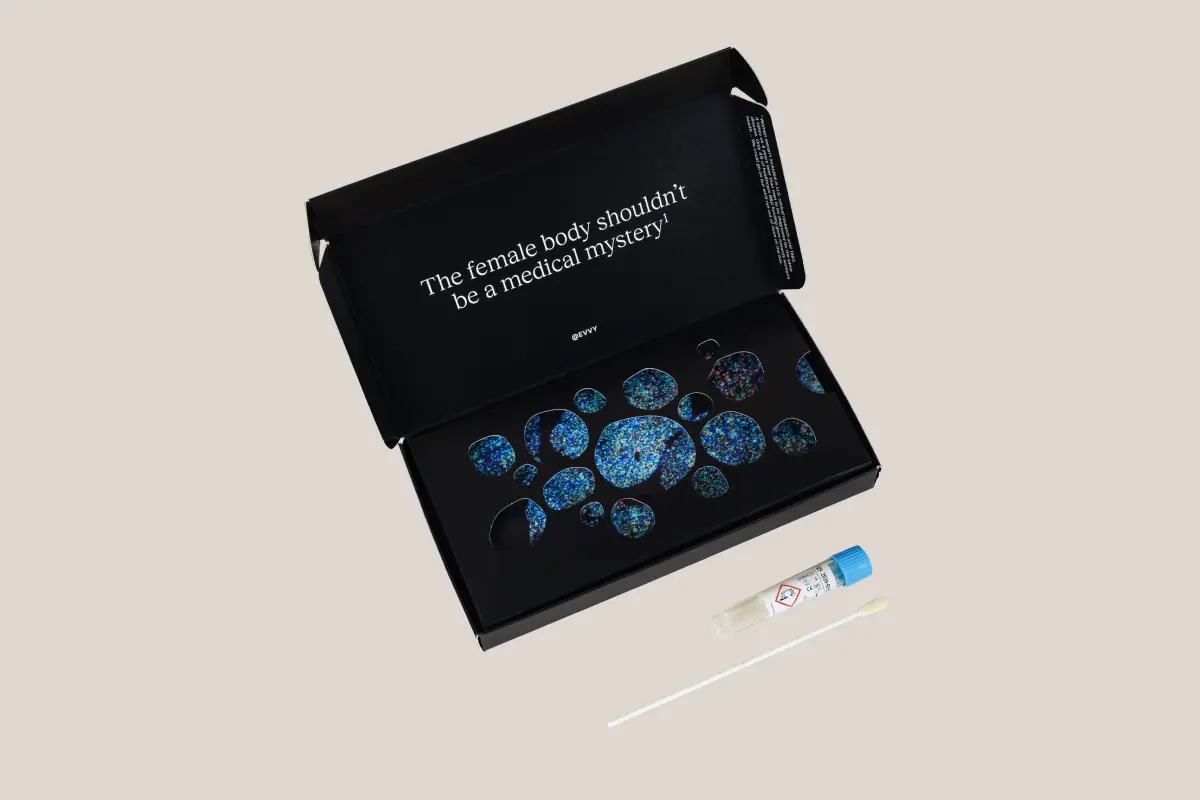

Vestibulodynia: Causes of Vulvar Pain & How to Find Relief
Vestibulodynia causes pain and irritation at the vulva’s entrance. Learn what triggers it, symptoms to watch for, and real options for managing the condition.
Words by Rachel Mantock
Scientifically edited by Dr. Krystal Thomas-White, PhD
Medically reviewed by Dr. Christine Vo, MD
There are times in our lives where you may find yourself wondering, Why does my vagina hurt?
There’s so much we don’t know about vaginal health, so vaginas can often seem temperamental. After all, pain in the vulva could be anything from a yeast infection to a physical injury to that new sex toy you got a little trigger-happy with (no judgment, we’ve all been there).
But when this type of pain is persistent and your doctor is just as confused as you are (because tests can’t find anything), you may want to consider vestibulodynia, a condition that’s defined by pain around the entrance of the vagina with no obvious explanation.
Read on to learn more about the types of vestibulodynia, its symptoms, causes, and risk factors below.
What is vestibulodynia?
Vestibulodynia, also known as vulvar vestibulitis syndrome (VVS), is chronic vulvar pain that can be felt at and around the entrance (vestibule) of your vagina.
Vestibulodynia (like clitorodynia, which is persistent pain in the clitoral area) is a type of vulvodynia, which is an umbrella term for persistent, unexplained vulvar pain.
What does vestibulodynia feel like?
The way someone experiences and describes vaginal pain will be different to the next person. That being said, there are common symptoms. Typically, vestibulodynia feels like:
- Burning, stinging, or rawness in the genital area and the entrance to your vagina
- Throbbing pain in the genital area and entrance to your vagina
- Stinging in your urethra, and the irritating urge to pee immediately after sexual intercourse.
These last characteristics of vulvodynia are not to be confused with the urge to pee during sex, which without pain or other symptoms, can be a sign that fluid ejaculation (from the vagina) is about to happen. This is normal (not shameful), and you shouldn’t feel uncomfortable.
Types of vestibulodynia
There are two main types of vestibulodynia, “provoked” and “unprovoked”. As you may have guessed from the name, you fall into either category based on what seems to have triggered your pain.
For example, was there physical pressure involved (such as vaginal penetration or even being touched in that area)? Or was it seemingly random, where no obvious pressure was applied?
Provoked vestibulodynia
The most common type of vestibulodynia, “provoked” vestibulodynia (PVD), tends to happen after some form of physical pressure in the vaginal entrance area. After said physical contact, the pain response has to last for at least three months to be considered PVD.
Spontaneous vestibulodynia
When pain around the vaginal entrance happens without physical pressure or being touched in that area, it’s known as “spontaneous” vestibulodynia.
Potential causes and risk factors for vestibulodynia
Like many other acute and chronic conditions specific to women and people with vaginas, the scientific community still does not understand the exact causes or risk factors for vestibulodynia.
You can think of our current understanding of vestibulodynia as having just a few pieces of a 1,000-piece jigsaw puzzle. We have a few good clues, but not enough to make a complete picture.
So far, researchers think both types of vestibulodynia are linked to nerve cells (neurons) and how they process information. Neurons are responsible for transmitting all physical stimulation to our brains, they are key players in how we process and experience sensations, like touch, pressure, and even pain.
The problem with all conditions that cause unexplained pain is that we know the neurons are stimulated, but we don’t know why they’re being stimulated. It could be that the neurons have been overstimulated and respond to the slightest thing.
For example, if you have a history of recurrent infections, then your neurons are primed to respond, and the slightest change will set them off. There could be a genetic component where the signals to the brain are being misinterpreted as pain when it should be pressure or itchiness. Or it could be something else entirely, like prolonged localized inflammation.
Vestibulodynia most likely has a wide range of causes, all with the same symptoms, kind of like the common cold. We don’t know what specific virus gave you the cough and sniffles, it could be one of many different options. For the common cold, we don’t need to know the cause; we treat the symptoms, and it goes away eventually. But for pain conditions, knowing the cause makes all the difference. Until we know more, we have to keep treating the symptoms.

Recurrent symptoms? Get Evvy's at-home vaginal microbiome test, designed by leading OB-GYNs.
Risk factors for vestibulodynia
Generally, scientists are now leaning towards a neurobiological explanation for vestibulodynia. However, research suggests vestibulodynia may be more likely if you have:
Recurrent vaginal infections
Some evidence suggests pain from vaginal infection (especially yeast infections) may linger after the causative agent is gone. This is thought to be the result of inflammation, but more research is needed to confirm this.
Hormones
Genital pain is linked to levels of circulating gonadal hormones, like estrogen. Increasing circulating hormones (like with combined hormonal birth control) can cause changes in the moist, inner lining of the vaginal entrance that make it more sensitive to touch. But decreasing hormones (for example, with anovulation, lactation, anorexia, over-exercising, and persistent physiological stress) are all linked to vestibulodynia symptoms as well. The decrease in estrogen during menopause might increase your risk for vestibulodynia, but it is more common in women who had vestibulodynia when they were younger and now have a recurrence during menopause.
The vaginismus link
Vestibulodynia and vaginismus are two interconnected conditions that can lead to painful experiences during sexual activity or tampon insertion. Vaginismus involves the involuntary tightening of the vaginal muscles, which can make vaginal penetration difficult or impossible. This tightening often comes with pain, making the experience distressing.
Genetic predisposition
There is some evidence that vestibulodynia runs in families, and people with vestibulodynia have more nerve growth in their genitals. We are only beginning to understand all the genes necessary for normal neuronal signaling. But a few studies have shown that specific genetic mutations can increase your risk for vestibulodynia. Such as certain genetic mutations that might increase your risk of yeast infections or other vulvar infections, genes that can cause “exaggerated inflammatory responses”, or create stronger hormonal responses to oral contraceptives, can all impact your chances of developing vestibulodynia.
Could there be a relationship between shifts in vaginal flora and vestibulodynia?
Maybe, but it is too early to tell. We do know that people with vestibulodynia have more inflammation around the nerves in their vulvas. The vaginal microbiome may be playing a role in creating that local inflammation.
However, no single organism has been shown to be the cause. There have been only three studies looking at vestibulodynia and the vaginal microbiome. One suggested that L. gasseri was associated with vestibulodynia, another found Bifidobacterium, Mycoplasma, and Fenollaria were potential biomarkers, and a third found a yeast, Aspergillus, was associated with symptoms.
One of the reasons that these studies have conflicting results is that each study had a small sample size (about 20-29 women per study). With so few women studied, and the potential variation in the cause of symptoms, it is hard to draw any conclusions.
How common is vestibulodynia?
Not surprisingly, vestibulodynia is probably more common than you’d expect. At least 7% and up to 28% of women in the U.S. have experienced vestibulodynia in their lifetime.
Not everyone will be comfortable enough to talk about these symptoms with their doctor, though. So, on top of all of this, vestibulodynia is most likely underreported. It’s estimated that half of women with vulvodynia don’t seek medical help. For those that do, only a fraction will be correctly diagnosed.
Treatment and management options for vestibulodynia
The frustration of experiencing chronic pain without an obvious cause is like no other. Often, people question their sanity, and this can be exacerbated by feeling dismissed or not believed when seeking help. But remember, nobody knows or experiences your vagina like you do.
Pain management
Right now, most treatment options for vestibulodynia are focused on managing or reducing the pain, but not solving the underlying cause. Since the underlying causes are unknown at this point, treating the pain is kind of like the next best thing. Though anyone experiencing chronic vulva pain will tell you, this approach falls short by a long margin.
If you’re experiencing symptoms of vestibulodynia, consider bringing up psychotherapy and physical therapy with your doctor. A study that compared both treatments found that 70% (the psychotherapy group) and 80% (the physical therapy group) of patients felt less pain. After a six-month follow-up, these improvements more or less held on. Plus, both groups felt more able to have sex without stopping because of pain.
Steps to managing vestibulodynia pain include:
- Avoid using feminine hygiene products with fragrances or other irritants on your vulva.
- Temporarily stop having sex if you find it painful, or explore non-painful forms of sexual intimacy as an alternative.
- Talk to a therapist (there’s emerging evidence to suggest that sharing this issue with someone, and having them respond with empathy, can help alleviate this type of pain).
- Try physical therapy for the pelvic floor muscles. The most up-to-date research shows that pelvic floor physical therapy is effective at treating vulvodynia and vestibulodynia.
- Topical lidocaine (a numbing agent) ointment.
- Surgery (in rare or extreme cases of long-term vestibulodynia, but it’s very much seen as a last resort).
Vestibulodynia and mental health
At least 70% of the time, vestibulodynia is also linked to pain during sexual intercourse. Naturally, this can have knock-on effects on mental health and put stress on sexual relationships.
It’s almost taboo to admit that sex is a big part of relationships (for most people). So while it’s not the be-all and end-all, it’s a pretty big deal. Especially when it comes to our own physical and mental well-being. Vestibulodynia can throw a spanner in the works for all of this. As we said before, talking to someone has been shown to help.
We don’t talk about our vulvar pain enough
And when we do, it’s often labeled a non-issue. Vaginal pain or discomfort simply isn’t taken very seriously and this can affect mental health. Plus, there’s still a huge amount of shame and stigma attached to talking about it. It’s no wonder some of us find it difficult to ask for help.
But the good news is, surveys that directly ask women about their symptoms lead to higher rates of diagnosis. A great example of this is the first validated vulvodynia questionnaire for self-reporting, created in 2020.
The science is getting there (slowly). Until then, don’t be silent about your vaginal pain. You deserve help, and Evvy is here to help you.
FAQs
What is the cause of vestibulodynia?
The cause of vestibulodynia is not fully understood. Both types of vestibulodynia — provoked and spontaneous — are linked to how nerves process sensations. Nerves are important for sending physical feelings to the brain, affecting how we feel touch, pressure, and pain. Although we know that these nerves are activated, we don't fully understand why they are overstimulated. This overstimulation could be due to a history of infections that caused hypersensitive nerve endings, genetic factors causing signals to be misinterpreted as pain instead of pressure, or prolonged inflammation. In essence, vestibulodynia likely comes from various underlying factors, much like how different viruses can cause a cold. Until we know more, the focus of treatment is on managing symptoms and improving quality of life.
What is the difference between vulvodynia and vestibulitis?
Vulvodynia and vestibulitis are both conditions characterized by vulvar pain, but they differ in their specifics and areas of discomfort. Vulvodynia refers to chronic, generalized pain of the vulva, the external part of the female genitalia, which can be diffuse or localized but is not limited to a specific area. It often lacks a clear cause and may be associated with various triggers. On the other hand, vestibulitis, also known as vulvar vestibulitis, is a type of vulvodynia specifically affecting the vestibule, the area around the vaginal opening. It typically involves pain and tenderness localized to the vestibular region and can be triggered by touch or pressure. Both conditions involve vulvar pain, but vestibulitis is more narrowly defined and localized, whereas vulvodynia encompasses a broader range of pain affecting the entire vulvar area.
What hormones are involved in vestibulodynia?
Hormones play a role in vestibulodynia, though the exact mechanisms are not fully understood. Estrogen is really important because it helps keep the vaginal tissues healthy and lubricated. Changes or imbalances in estrogen levels, like during menopause, pregnancy, or with certain contraceptives, could contribute to vestibulodynia by affecting vaginal tissue sensitivity and inflammation. Also, progesterone, which fluctuates during the menstrual cycle, might influence pain perception and tissue response. These hormonal changes can affect the vaginal mucosa and the underlying neural tissues, potentially making vestibulodynia symptoms worse. We still need more research to fully understand how these hormones interact with the condition.
How common is vestibulitis?
Data shows that vestibulitis will affect about 10–15% of women at some point. That said, it’s hard to know for sure how common vestibulitis is. It’s a poorly understood condition, and female pain is largely normalised in the medical world. When you pair that with the fact that many women might feel embarrassed about seeking help for vulvar pain, the numbers could be a lot higher.





